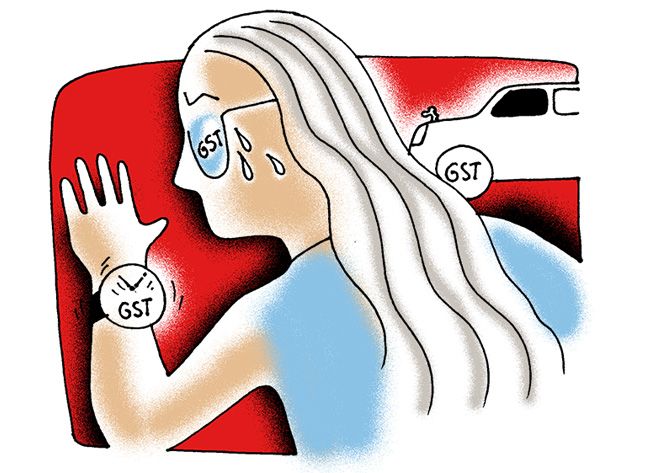While the November 2017 round of rate revisions saw mainly eating joints unwilling to pass on GST benefits, this time round, sanitary napkin makers, TV manufacturers and even paint companies have said passing on GST benefits is not a feasible exercise.
Illustration: Dominic Xavier/Rediff.com

The latest round of rate revisions introduced by the Goods and Services Tax (GST) Council on July 21 has led to a peculiar situation.
The number of companies unwilling to pass on GST benefits is higher than in previous rounds.
While the November 2017 round of rate revisions saw mainly eating joints unwilling to pass on GST benefits, this time round, sanitary napkin makers, TV manufacturers and even paint companies have said passing on GST benefits is not a feasible exercise.
Firms in each of these categories have their reasons for the resistance.
The Feminine and Infant Hygiene Association (FIHA), which represents the country's top sanitary napkin makers including Johnson & Johnson, Procter & Gamble, Kimberly Clark and Unicharm, said the decision of putting the item on the exempt list was unlikely to achieve the desired objective.
“The exemption of sanitary napkins from GST effectively denies input tax credit to companies manufacturing in India. As a result, in order to offset the loss, companies will not be able to pass any significant benefit to consumers,” FIHA said.
While the government has asked for a break-up of the costs involved in making sanitary napkins, players argue that putting the item in the exempt list will benefit importers.
“We pay 18 per cent GST on inputs used for making sanitary napkins. A 12 per cent GST on finished products allowed us to avail a set off (against input tax), which will not be there now.
"This will make it unviable for us to make sanitary napkins locally, boosting imports instead,” said Kamal Johari, managing director, Nobel Hygiene, said.
TV manufacturers, meanwhile, have said passing on GST benefits in small TVs upto a screen size of 68 cms was a meaningless exercise.
“The 26-inch TV segment is not more than 8-10 per cent of the overall TV market. Whereas the 32 to 43-inch TV segment constitutes almost two-thirds of the overall TV market and is critical for most players,” said Rohit Kumar Singh, spokesperson, Consumer Electronics and Appliances Manufacturers Association (CEAMA).
“Most middle-income homes in India have TVs in the 32 to 43-inch bracket and significant number of launches and innovations happen in this segment,” he said, adding extending the 10 per GST rate cut to TVs with a screen size of upto 142 cms (or 43 inches) was a better thing to do.
CEAMA last week made a representation to the government asking for the same. It also highlighted the need to increase import duty on TV components since the GST rate cut would fuel further imports into the country.
Asian Paints, in contrast, has said it would have to assess when to pass on the GST cut of 10 per cent.
“While we will have to pass them on, we’d have to assess when to do it,” he said following the company’s first-quarter results last week.
“Every time there is a price change, there is a lot of instability in the market and ideally we do not like to disturb the market before the festive season,” he said.
HM Bharuka, managing director, Kansai Nerolac, meanwhile said the company would pass on the GST benefits to consumers despite input cost inflation.
Eating joints, on the other hand, have found themselves under government scanner in the last nine months for their inability to pass on the 13 per cent GST rate cut announced in November.











